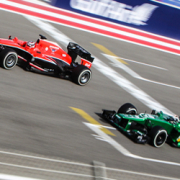Which scenario would be expected with the 107% rule?
 On Thursday 27th Formula 1 will go back to the Sakhir circuit, where the last session of pre-season test will take place until March 2nd – before the Australian GP, which is scheduled for March 16th, takes place.
On Thursday 27th Formula 1 will go back to the Sakhir circuit, where the last session of pre-season test will take place until March 2nd – before the Australian GP, which is scheduled for March 16th, takes place.
Four days and three weeks before the first event of the season takes place, teams seem to still have many problems to face. In this last pre-season session teams will have to get their cars prepared for racing, besides moving forward with the cars development, however today a key factor is still missing: how about the 107%? “I don’t want to pour salt into a wound, but there are still many unclear points, especially in light of what we saw in Bahrain last week”, says Gian Carlo Minardi on his website www.minardi.it.
“Apart from having reliability issues, the 107% policy limit hasn’t been duly taken into account. If we take a look at the 4-day-session’s standings and timesheets, we realize that only 14 cars would have been qualified, if we compare the test times they recorded with Nico Rosberg’s best time”, continues the manager from Faenza.
So, today, 40% of the cars wouldn’t be qualified “Besides having reliability-related issues, the 107% rule should have been also taken into consideration. It’s true that exceptions exist (as we saw in the past seasons),however, it is necessary to record a time within the 107% rule, at least in free practice, to qualify….Today cars have difficulty running a few laps in a row, or they have to turn off the energy recovery systems (which is not easy to do) in order to run as many kilometres as possible, but, as a consequence of that, they become less performing. This season, using the KERS means to have a 4-second-advantage on a single lap, which is equal to 90 HP.” So the safety car could play a key role “I expect the safety car to be deployed very often, since its deployment is directly linked to the rescue crew intervention time. We don’t have to forget that the rescue crew cannot get into action before the green light, which is installed on top of each car, switches on. When the green light is switched on, the rescue crew can get into action and take a car away from the track. This could make intervention time much longer and, as a consequence, the safety car would be deployed more often.”
 After the last test session in Bahrain, a new briefing will be scheduled to define regulations “After the last test session a briefing would be arranged to discuss the madness of the double-point rule for the season finale. At this point I think it’s necessary to revise the 107% rule, without ruling it out”, ends Minardi “I’d like to point out that this rule should only be revised, not ruled out because it would be difficult for race commissioners to deal with cars which have a huge technical gap between each other.”
After the last test session in Bahrain, a new briefing will be scheduled to define regulations “After the last test session a briefing would be arranged to discuss the madness of the double-point rule for the season finale. At this point I think it’s necessary to revise the 107% rule, without ruling it out”, ends Minardi “I’d like to point out that this rule should only be revised, not ruled out because it would be difficult for race commissioners to deal with cars which have a huge technical gap between each other.”



